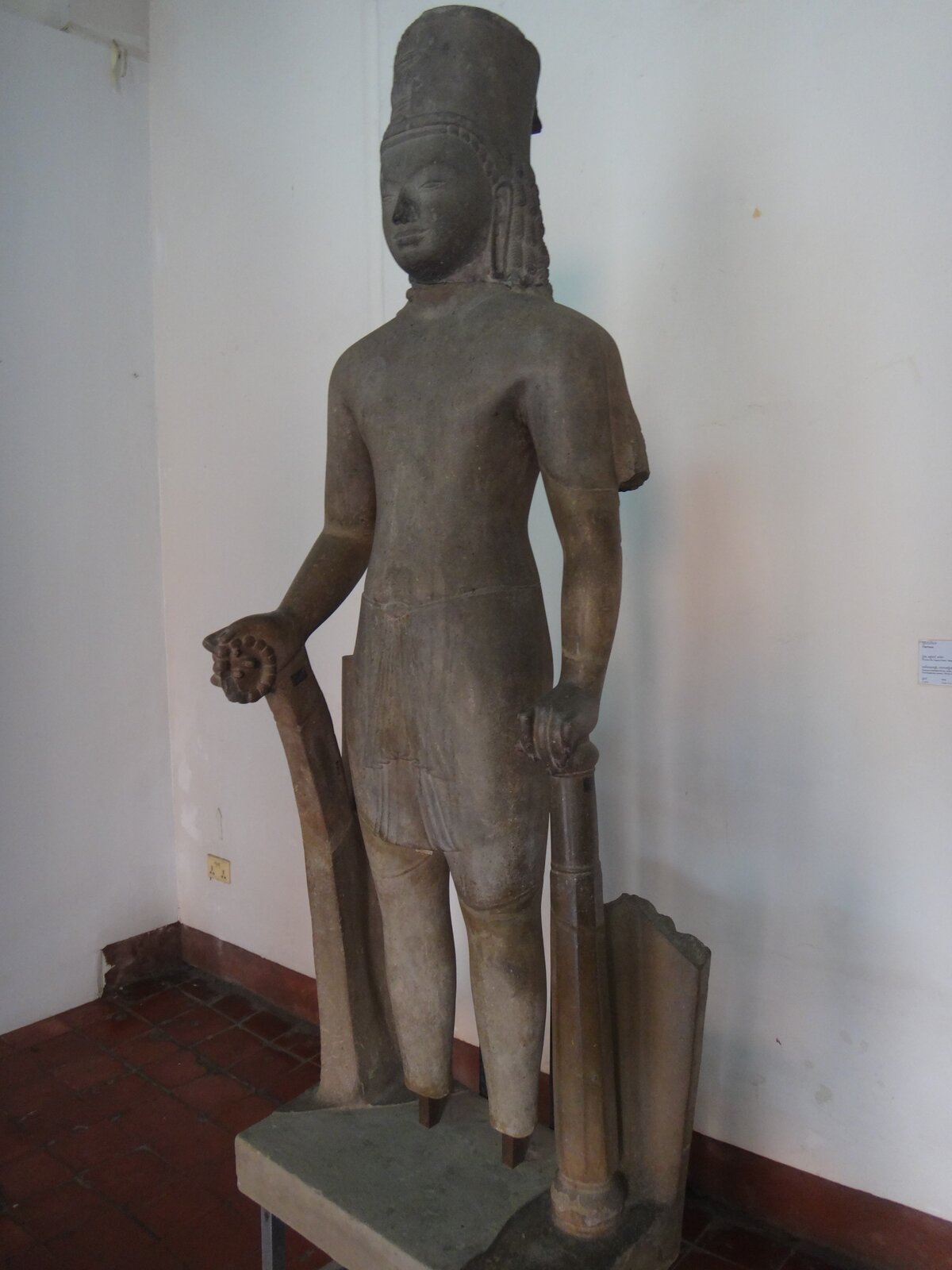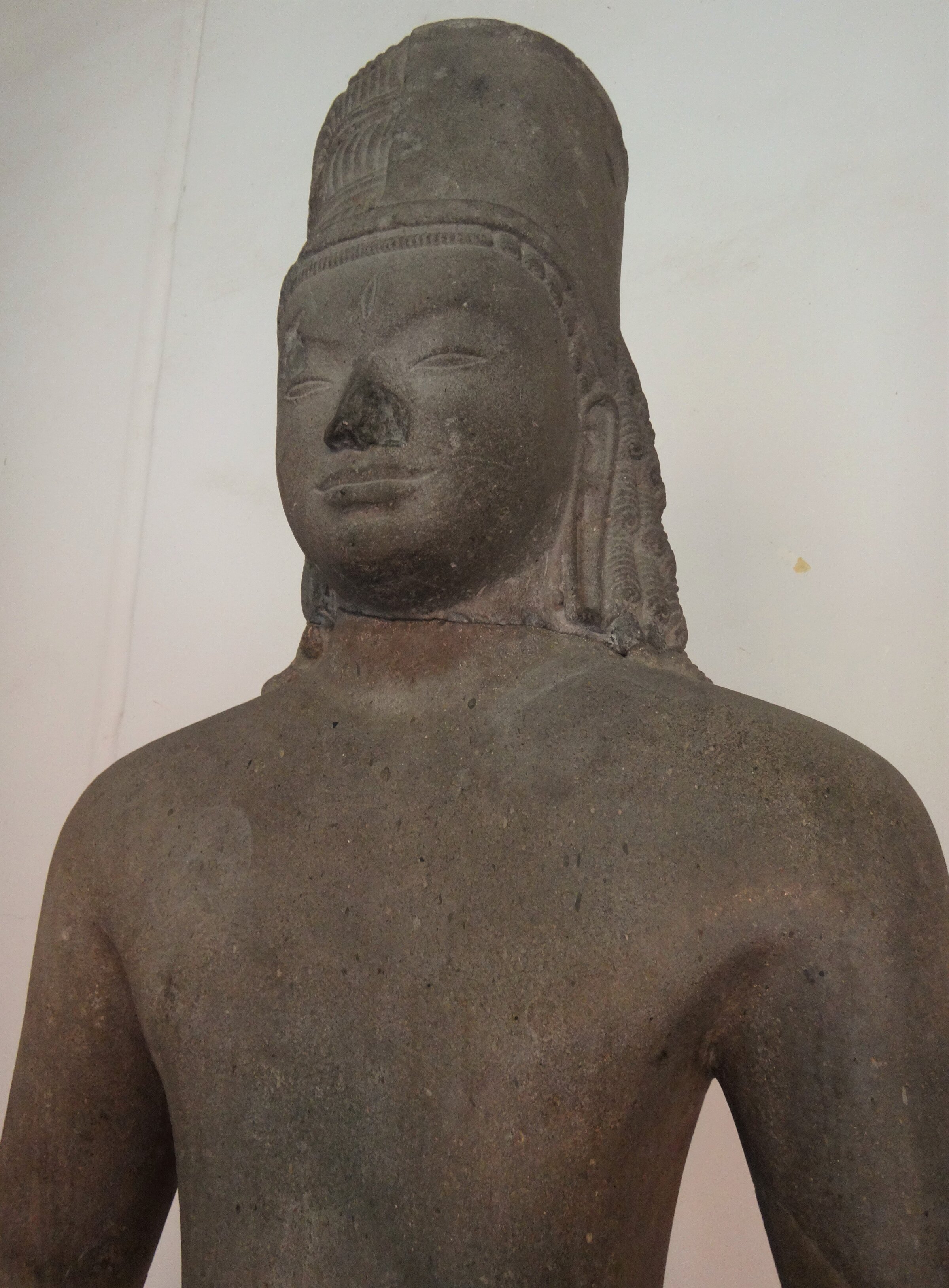Harihara - Phnom Da
by Andy Brouwer
Entry#9 in Khmer Art Worldwide Collection

Published: October 26th, 2021
Author: Andy Brouwer
- Height (cm): 190. Sandstone
- 6-7th century
- Provenance: Phnom Da, Angkor Borei, Takeo Province
- Location: National Museum of Cambodia, Phnom Penh
- Catalogue Number: NMC Inventory Ka.1614
- Status: On display
- Photo credits: Andy Brouwer
This instalment from the vaults of the National Museum of Cambodia relates to a joyful reunion at the beginning of 2016 when the head of a magnificent statue, which had spent the previous 130 years in the Guimet Museum in Paris, was reunited with its body in the National Museum. The nearly six feet tall statue is that of Harihara, a deity that combines aspects of Vishnu and Shiva, the two most important gods in the Hindu pantheon, who represent the creation of the universe and its destruction.
In 1882 French scholar and colonial administrator, Etienne Aymonier, collected the head from the hilltop temple of Phnom Da in the Angkor Borei region of Takeo province, and with the permission of King Norodom, transported it with other artifacts to France, where it was put on display at the Paris Universal Exhibition of 1889 before being deposited with the collection of the Guimet Museum in the French capital.
Meanwhile, its massive body had lain undisturbed in-situ at the ruined temple until 1944, when it was transferred to the museum for safe-keeping. A decade later the former curator of the National Museum, Pierre Dupont, suggested the head in the Guimet might match the body in Phnom Penh. Despite his foresight, it took more than fifty years before his hypothesis was tested and proved correct.
The artistic style of Phnom Da is marked by influence from India and the museum holds a number of fabulous examples of this early 7th century period. Harihara would usually possess four arms, though the upper arms are broken off and the horseshoe arc that supported the upper arms is missing too. The lower hands contain a rosary and a mace. The combination of features on the head signify Shiva with a matted chignon formed by loops of hair, and half of the third eye on the forehead, while Vishnu has a cylindrical miter on his side of the head.
The statue’s head is technically on loan to Cambodia for a five-year period, while travelling in the opposite direction, a pedestal and the feet of the dancing goddess Uma, from Koh Ker, was sent to France. The head finally arrived at the museum at the start of 2016 after ten years of negotiations between the two museums and was the subject of a welcome home party, where today it is on public display, proudly re-attached to its body.
Tags: Harihara, Phnom Da style, Khmer sculpture, Pre-Angkorian, museums, National Museum of Cambodia, art restitution
About the Author

Andy Brouwer
Cheltenham-born and bred, Andy Brouwer (1959, UK) made his first trip to Cambodia in 1994, and that white-knuckle ride hooked him for life. He upped sticks to Phnom Penh in 2007 after more than thirty years in banking back in the UK to join Hanuman Films.
As well as having a serious obsession in temples, books -- he’s the editor of the guidebook To Cambodia With Love --, and pretty much all things Khmer, he is a lifetime supporter of Leeds United and has an insatiable passion for the music of Steel Pulse and Ennio Morricone. His website relives his numerous visits to Cambodia, and more.
During his time living in Cambodia, he’s been a producer and researcher for Hanuman Films, a product manager at Hanuman Travel, and the media officer with Phnom Penh Crown FC. Since 2020, he developed a personal research, Exploring Khmer Art Worldwide, published as an ongoing series on his Facebook page, that will be soon hosted on Angkor Database.

